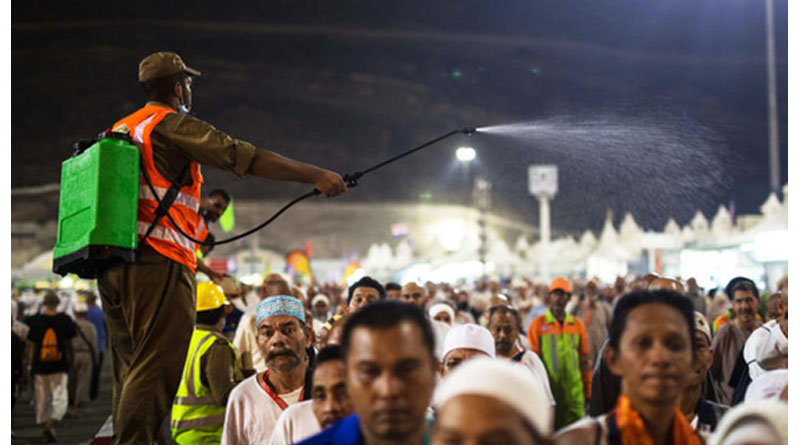24-Hour Service to Treat Sun, Heatstroke Victims During Haj

Saudi security guards sprays water over pilgrims to cool them down as they walk back to their tents after casting stones at Jamarrat pillars, a ritual that symbolises the stoning of Satan, during the annual pilgrimage, known as hajj, in Mina, near the holy city of Makkah, Saudi Arabia, in this Sept. 25, 2015 file photo. (AP)
MOHAMMED RASOOLDEEN
RIYADH: In view of the scorching summer heat during this year’s Haj, the Ministry of Health (MoH) has implemented an around-the-clock plan to treat sun and heatstroke patients instantly, a senior official from the ministry told Arab News on Wednesday.
Confirming the readiness of the ministry for any emergencies, the official said the ministry has chalked out a comprehensive program to cover pilgrims in Makkah, Madinah and other holy sites such as Mina, Muzdalaifah, Jamaarat and Arafat.
The health officials who are assigned for the purpose are well trained and their vehicles are fully equipped with the state-of-the-art facilities.
The emergency complex at Al-Muaisam has been equipped with around 120 small ambulances and 57 “sanad” vehicles used in field medicine. The supply center warehouse at Arafat General Hospital is loaded with drugs, solutions and medical supplies to deal with support and emergency cases, and to cater to all health centers and hospitals in Arafat.
In addition to preparing a large refrigerated vehicle loaded with medical solutions, emergency drugs and medical supplies to deal with emergency cases, a similar stock of supplies is also available in the warehouse at Mina Al-Wadi
Three refrigerated vehicles loaded with drugs, medical solutions, emergency drugs and medical personnel are stationed at Jamaarat Bridge, Al-Haram area and a third at Arafat.
The MoH this year also implemented a number of new health and developmental projects at the holy sites to offer therapeutic services to pilgrims to meet the aspirations of the government.
The developmental projects include opening a gate and passage for ambulances at Al-Muaism emergency complex, and improving the general site of a number of health centers.
Also, sunstroke units have been equipped with sunstroke and heat stress devices, where water sprinkling fans are provided, along with places for treating heat stress patients in the MOH’s hospitals at the holy sites
Furthermore, the Haj projects and engineering affairs committee is following up on medical and non-medical maintenance work for the holy sites’ hospitals to ensure their readiness to receive patients.
The ministry has also installed 208 additional fans in Makkah and its holy sites for better ventilation, and to relieve Haj pilgrims from the scorching summer heat.
The ministry has plans for dealing with heat exhaustion and sunstroke among pilgrims.
There are four hospitals each in Arafat and Mina. In addition to these, there are 80 primary health care centers in Arafat, Mina and Muzdalaifah, which will receive pilgrims during Haj.
Last year, the ministry updated its facilities at these centers and they are now ready to serve pilgrims during the latter part of the Haj season. The centers include 28 in Mina, 46 in Arafat, and six in Muzdalaifah.
Health officials have also been assigned to 15 ports of entry for land, sea and air to monitor health conditions of pilgrims. “They are expected to take preventive and curative measures to keep infections under control,” the official said.
He said that health officials at the ports of entry will ensure that pilgrims have had all vaccinations before arriving. “If they have not been vaccinated, doses will be given at the ports,” the official said.
Healthcare workers will report any developments to the central command committee on a 24-hour basis. All health officials who serve pilgrims will wear face masks during their interactions with pilgrims.
The functions of the Haj committees are interlinked through an electronic network to ensure integrated health care services.
The ministry recruits more than 22,000 people from various medical, technical and administrative categories for the Haj season every year. Officials also include some 400 medics in rare medical disciplines, including intensive care and resuscitation, as well as specialists in intensive care nursing and other emergencies.
As part of an awareness campaign, officials will urge pilgrims to focus on personal hygiene, and hygienic cooking, storing, transporting and serving methods of food, which are important to avoid diarrhea and vomiting, food poisoning, dysentery, typhoid and cholera.
Hands should be washed before eating. Disposable shaving kits should be used.
Wearing masks made of cloth during the performance of various Haj rituals will be very useful in preventing respiratory infections such as colds, coughs and sore throats.
(Source: ArabNews.com)


